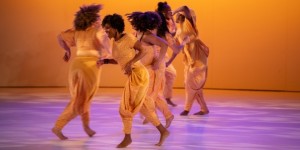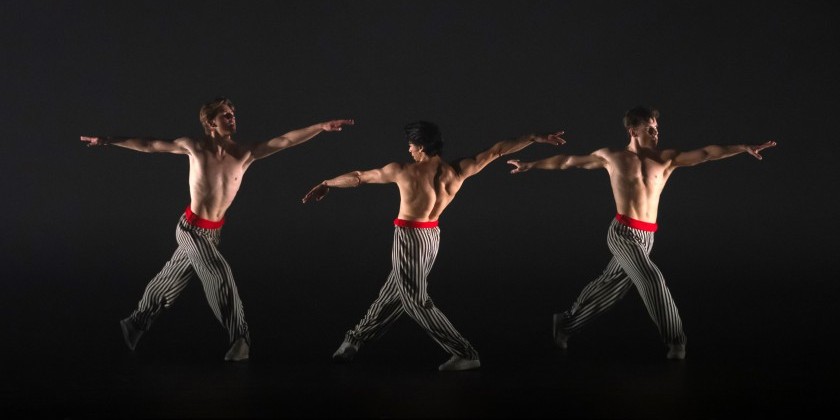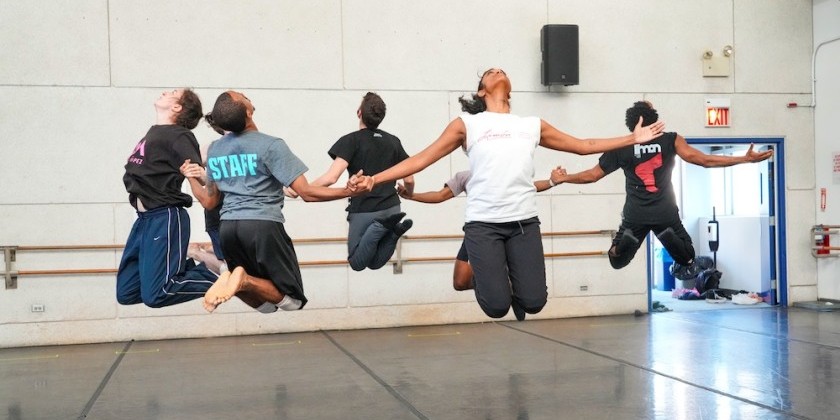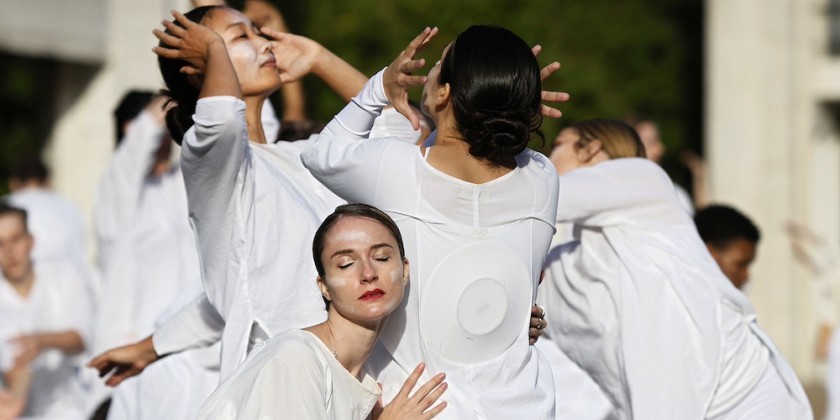Former Murray Louis Dance Company Members Perform Their Mentors Work

Former Murray Louis Dance Company Members Perform Their Mentors Work at the American Dance Guild’s Upcoming Festival- Dance New Amsterdam-Sept 11-Sept 14th 2008
Videography/Interview-© 2008 Christine Jowers /for The Dance Enthusiast
I was fortunate enough to watch last Sunday as Janis Brenner, Michael Blake, Betsy Fisher, Peter Kyle, Sara Pearson, and Robert Small rehearsed Murray Louis’s delightful “Porcelain Dialogues.” I didn’t know that I would also get the chance to see Fisher perform a saucy solo from “Figura”, and Kyle transform character and shift mood in the constantly surprising tour de force, “Frail Demons.” It was a great day for me, being the audience for these artists as they worked, perceiving not only their beauty when “performing” but witnessing the beauty of their desire to perfect, to clarify, and to always discover something new in this work they have danced for years.
Janis Brenner originally brought the group together for her 25th Anniversary Performance at St. Marks Church in 2007. Each artist has danced with Brenner throughout her seven-year career in the Murray Louis Company. Besides the fun of getting together with old friends who share an artistic viewpoint it is very important to Brenner that the fine work of Murray Louis remain in the consciousness of the dance community.
It seems that the American Dance Guild Agrees.
Video Clips: Robert Small Speaks About Working with Murray Louis
Editors Note: Robert Small is misspelled in our video. His name is not Robert Smalls but Robert Small - Our Apologies
"Just to invent this “new” company to do this work that really should be seen and should be back in the canon of important dance work is part of ... became my mission in wanting to do this... It’s a different way of seeing work, a very specific idiosyncratic aesthetic that Murray has that is very rich and some of it is just genius."
Christine Jowers (CJ)
How long were you with Murray Louis?
Robert Small (RS)
I was with Murray for 10 years. From 1971 till about the middle of 1980.
CJ
How did you meet him?
RS
I met him at UCLA back in the late 1960s. The University of California System had guest artists coming through... and so Murray and Nik would come through every other year and Lotte Goslar, Jose Limon... That was a time when we were lucky enough to actually work with these artists and they could set works on us as students... and Murray asked me after my Junior year- “What’s your plan for next year?” and I said, “Well I have one more year before I graduate.” and he said “ok good- stay in school keep in touch.”...He came back the next year and said, “I have a place for you in the company.” I went right out of UCLA and was fortunate enough to get a job with Murray.
CJ
What was the most important thing you learned from Murray?
RS
I think for me it just was having the body be expressive and be an instrument for whatever you want to say, not in a dramatic sense, but in trying to find an abstract way, trying to find a language for each dance. That was what Murray did with all of his choreography. Every dance was unique and different, had a different point of view and a different movement vocabulary. It wasn’t re-arranging steps, which is often the case with choreographers.
Murray would always dig very deeply to find a unique movement vocabulary for each piece.... that really is what helped us enjoy doing the work because on a program every piece was very different. (It was) just a joy and excitement for ten years to do his work.
CJ
Describe the rehearsal process.
RS
Murray did every movement and we were watching. He would do it once and if we missed it, we would miss it...he was so spontaneous in his creative output.
He did just about every step that I remember, and then we would learn it and he would look at it and mold it and change it and allow us to have freedom within that movement.
And certainly when the piece was choreographed then he really let us develop into it. He said it would take, he said “ Look dolls its gonna take at least a year for you to understand how to do this”- a year of dancing it- and it was true. So every performance we would find new things... and therefore we were able to feel it as individuals, not automatons trying to look like Murray...He would appreciate that because we were, we were a rather motley crew in those early years.
He specifically did that –he chose people that came from different backgrounds, and different educational areas, and different body types and somehow we would pull it together and he’d honor that, he’d honor that individuality and encourage that actually because that was one of the tenants of the Nikolais/Louis School- Through improvisation and composition, find your own voice.
CJ
Was it required to study with Nikolais and Murray at the School?
RS
It was so much fun that we would not think of going elsewhere.
I don’t know if they asked us specifically in our group in the 70’s. We probably never went anywhere else, unless somebody wanted to take a class in the evening after rehearsal.
That was just being part of the family...and also as company members, it would help the students to see the company members doing class. We didn’t come in as special people we were there from 10 o clock- we did class – we did improv- we did composition too-
We were there from 10 – 1 and then we would have a short break and then rehearse all afternoon. We danced all day long.
CJ
Porcelain Dialogues? You were in the original cast of Porcelain Dialogues... Is it similar (what you are doing) to the original casting?
RS
I don’t think Murray ever knew what the first step was going to be. He came in every time he started a dance, he would look at us, and we would be standing there ready and he would say, “What’s the first step?”
I think (for this performance with the American Dance Guild we are just doing a section) I think I opened Porcelain with a solo and I remember when you were given a solo by Murray it was something really really special. It was nerve racking. I think I had to do a leg extension or something.
CJ
I love the detail and simplicity of Porcelain Dialogues – the pictures you make and some moments that I didn’t notice at first- the fingers at the beginning (shimmering)...
Sara Pearson (SP)
The flowers.
CJ
Is that what they are?
SP
(shrugs)
RS
That’s the beauty of Murray. We never knew what he was going to come up with. I think he had the Tchaikovsky. I think he really wanted to choreograph to that. We didn’t know how he was going to handle it. Of course, he is so musical that we trusted that he was going to make something beautiful. And he did.
And this piece was so qualitative. It originally had six Plexiglas clouds around the back- this environment of qualitative beauty. And we had sparkles on our costumes. It was very different than the other pieces on the program it was like crystal ...in a crystal ball –quiet...
For me to come back to it is-The other dancers go, “ What was this?” So I come back and try to pull back those (original) feelings, they are so internal for me. Some of the dancers learned from the video or from 2nd and 3rd generation dancers. It is a real pleasure to come back and talk about it.
SP
I remember coming to New York to study with Nik and Murray in the.. . Summer of ‘73 than the fall of ‘73 -it was a scholarship. And Murray called me down to look at Porcelain Dialogues It was the first time they had run it and it was the first rehearsal I had seen the company do...The next year Murray invited me into the company. He expanded the company to fit me in and then I learned the piece.
Murray always started at the beginning of a dance. There was this incredible atmosphere of listening...and then he would say, just exactly what Robert said, “ What is the first step.”
And he would stand there, he would have his cigarette lit, and he would wait- and there was this marvelous atmosphere...He was listening for what is that first step.
And then he would do it and we would pick it up and ...would go through ...He would leave us and we would rehearse and we then would fight, you know, because Robert had the spatial sense, Michael (Ballard) was very particular about the shape... and we would sort of hash it out – “No it was this it was this” “It was this”. Each one had their own say...we were all coming to it from a different prism. Then we’d show it to him.
CJ
You all work so well together. How do you do that?
RS
We actually speak the same language.
CJ
Because of being together so long...
RS
Because of growing through the philosophy...it is so in us when we say a word like low diagonal or internal focus or graining in- these words don’t make sense to other people but they do to us. It’s a real vocabulary...
CJ
So now, do you all teach? Who continues this vocabulary?
SP
I am a choreographer and teacher and performer and I feel that Nik and Murray’s teaching are deep with in me. The vocabulary I use is very different.
RS
There are hundred, maybe thousands of people that have been influenced by Nik and Murray that are carrying on this tradition in their own way finding their own language- but still using the philosophical basis of this, and that’s what I think is unique about this technique a strong base that everyone can understand yet there is freedom within that to carry on in your own creative way.
I‘ve stopped dance. I have come out of retirement to do this (performance) I am a landscape designer. I stopped dancing in 1993.
CJ
You never stop dancing.
RS
Actually... I do a modified dance warm up every day, so I can come back to this environment. It takes me a little while, but I click back into the feelings... And this is a dance that is a qualitative dance and I can still fit in. The quality is so clear, spatially it is so clear. And we all understand the intent of it and we can manifest that. But when your working with revivals you know, I am not a big fan of revivals. Generation after generation it kind of loses a lot of the original intent ... that’s why I am happy to be part of this project. I am one of the originals so I can add a little bit... I watch the videos, and I still think it is a beautiful dance.
Janis Brenner (JB)
When I was fantasizing about who I was going to ask to do this (Porcelain Dialogues) when I first thought about it. (I thought) Robert. I knew he was retired -hadn’t danced in 13 years (laughs) Somehow he agreed to do it...He said sure.
RS
(Laughter) I said sure, not knowing what it would be like.
JB
I saw Robert and Danny Shapiro at a concert at Hunter...Boston Conservatory dancers doing Murray’s work... and I asked them if they would like to do Porcelain Dialogues and they said ...as long as they didn’t have to wear those unitards...(laugh) I said yah that’s fine...I changed the costumes, not the intent...we still kept the same sparkling tops.
I wanted to ask people who I had been in the company with from when I started to when I left...I would be the link that l that knew everybody even if some of them hadn’t danced together.
When I first came to the company, Robert and Sara were there, they were people I looked up to, along with Michael Ballard. After they left Betsy (Fisher) came in and Danny Shapiro came in. Those were the 2 I asked next...and then when I was leaving the company Michael Blake was there - ... (Here) was the more than 7 year history of who I had danced this piece with.
CJ
So what do you think about when you are dancing this piece again? Do memories flood back or is it the dance and a lot of specifics about the dance.
JB
I think it is a lot of everything. Definitely recalling the time and what it was like to dance with Sara and Robert when I was twenty-three, and how important it was to get into this piece in the company. Porcelain was like the thing to want to emulate to be in that piece because it was only for 6 people and there were 8 people in the company ... once you got elevated once you had really gone through your initiation of Murray’s work and company if you got into Porcelain Dialogues I felt you had “arrived” in a way.
Which happened after I had been there less than a year.
RS
When I am doing it now to me it is for the immediacy. I just know the feelings, the feelings, the kinetic feelings are the same as I had in the early 70’s and so I revel in that feeling again because not having danced for 15 years. The adrenalin flow of a dancer is unique I think, maybe athletes have the same, but when you add the artistic level of dance on top of the physicality, there are things that start pouring in your system ... I am sure it has been proven scientifically... For me to have that feeling again is very nice and it is a very specific feeling.... When you really get out on stage, we’re rehearsing now, but boy when you get out onstage you really feel, to me it’s almost super-human.
You feel lighter than you are and are floating on this dance space with light and the audience ... so for me to have this feeling again is quite nice and not as nerve racking as I thought.
JB
And also the fact that you’re doing this with colleagues you have danced together for so long with... You share this history of an aesthetic that is so ingrained in your system and your psyche that ... Its like being able to talk to people where you don’t have to go through the preliminaries of anything like – “Who are you?” “What’s your sign?” All of that stuff. Its so beyond that. You just know if somebody says,” should we grain into the movement”...We all know what that means... already on such a level of kinetic understanding that that’s what makes it so a profound to have again with each other.
RS
And the trust coming back into this. I just know that everyone the ensemble is right there ...I don’t get nervous about myself or anybody else in the group. I fall right back into a dance company.
CJ
You can feel that when you are in the room, it is like a family.
JB
I also think it is even more unusual because this is work that is just not done and not seen. And It’s not like you are reviving
another work in a company that says, “ ok we are going to revive this piece that we did 10 years ago”... This work has not been seen by hardly anybody- in more than ten years and some of these pieces have haven’t been seen in 15 years.
Just to invent this “new” company to do this work that really should be seen and should be back in the canon of important dance work is part of became my mission in wanting to do this.
Not just the challenge of how old we are and if we could do it, that was sort the fun of it too (laugh)
But to get it this work back into the consciousness of the dance community because when people saw this piece they were, oh my god...(commenting) the form, the choreographic structure, the musicality, the specific intention, the quality, its all there in 6 and ½ minutes.
It’s a different way of seeing work – a very specific idiosyncratic aesthetic that Murray has that.... is very rich and some of it is just genius.
In Conclusion
JB
(on Danny Shapiro who she had hoped would be part of the cast of her restaging of Porcelain Dialogues.)
I asked Danny to be in this work because he and I had been in the company for almost all the same years. I don’t know if you know but Danny had cancer- prostate cancer.
(Still) He was dancing and going like gangbusters...going to chemo, dancing again... But in the summer of O6 when we were rehearsing he was a little too sick to come... and that’s when I asked Peter Kyle to be his replacement... (Peter) joined the company when the companies merged (becoming Nikolais/Louis Dance Company) and he had learned this work...
Danny died ten days after the (summer 06) rehearsal period... Peter came in and was wonderful.... The piece is in honor of Danny Shapiro and Michael Ballard who was in the original cast, and was my partner for 6 years...(he) passed away of AIDS in 1991...
Murray has been to every performance...(before her premiere at her Celebration of 25 Years of Dance in St. Marks, Murray said) He said, “ Janis, doll, I am going to come with a big box of Kleenex next to me”
I think he is just very very touched that people who really care about his work are dancing it again.... and really with finesse and great great care to try to keep this work living...I think Murray appreciates it and loves watching it.
The American Dance Guild Festival 2008 offers a feast of new choreography along with tributes to the modern masters Murray Louis and Anna Sokolow.
Performances are
Thursday, Friday, Saturday- Sept 11, 12,13, 2008 at 8pm.
Saturday and Sunday Matinees-Sept 13, and 14th at 3pm
Location: Dance New Amsterdam (DNA)
280 Broadway, 2nd floor
Admission: At the Door 0, 5 for ADG Members, Students, seniors











